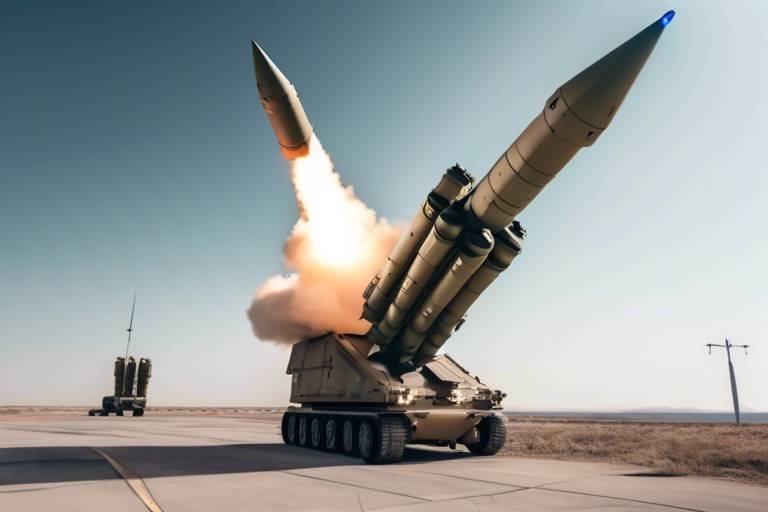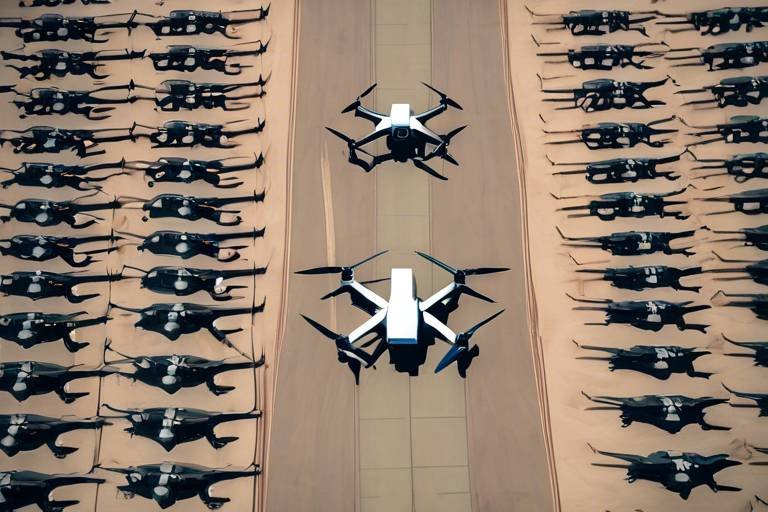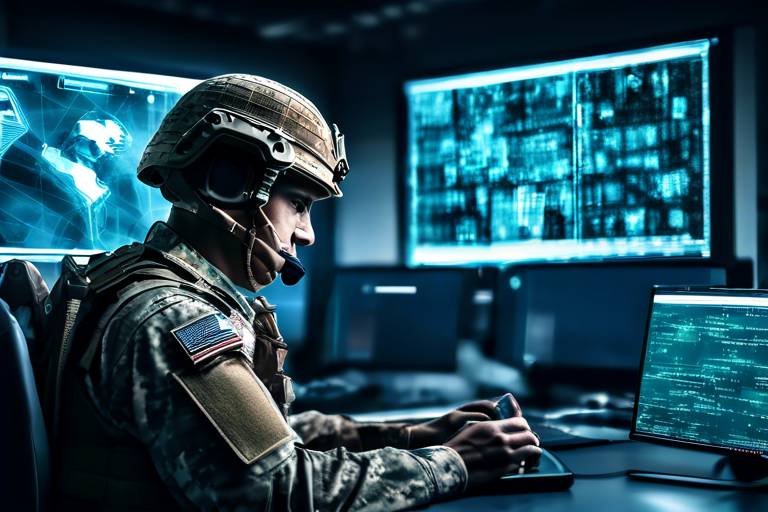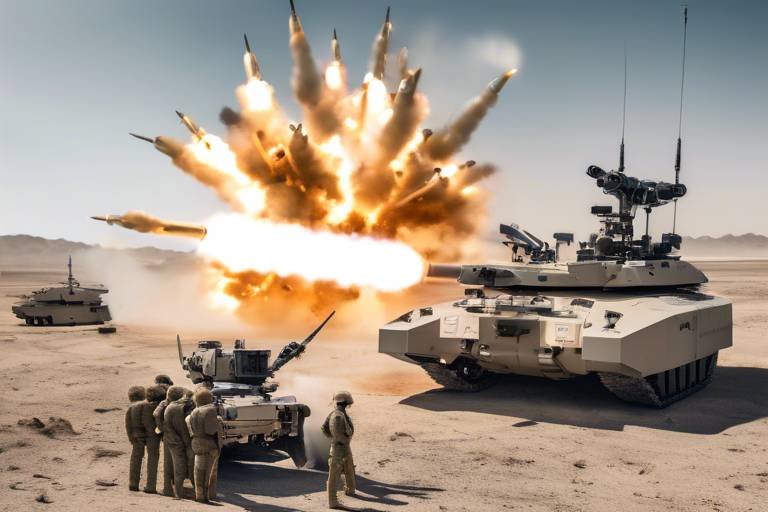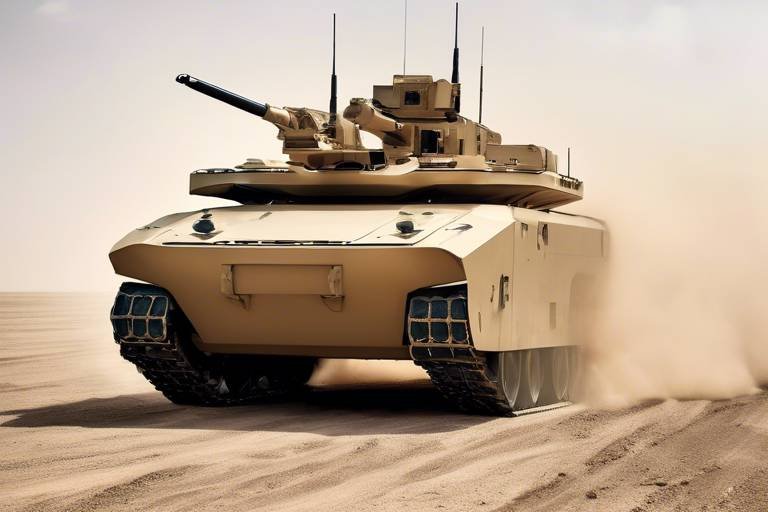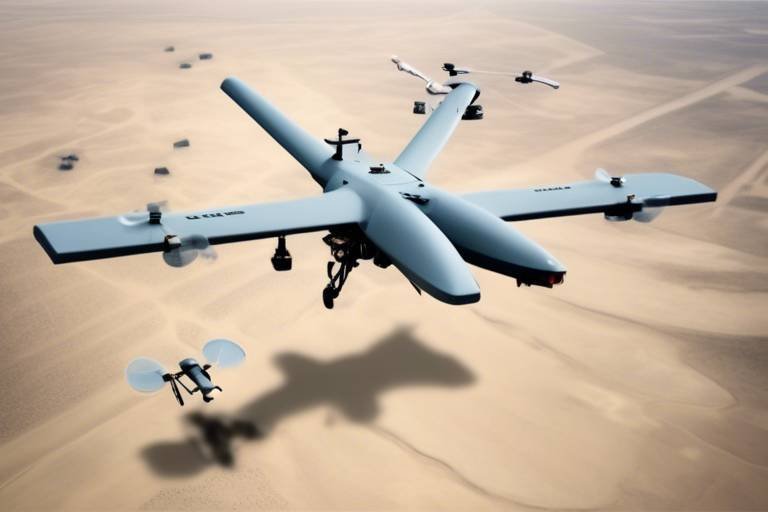How AI is Shaping the Future of Air Defense Systems
Artificial Intelligence (AI) is not just a buzzword anymore; it’s rapidly becoming the backbone of modern air defense systems. Imagine a world where military operations can predict threats before they even materialize, where systems can autonomously engage targets with lightning speed, and where decision-making processes are enhanced by data-driven insights. This is not science fiction—it’s the reality that AI is crafting for us today. As we delve deeper into the transformative role of AI in air defense, we will uncover how it enhances threat detection, integrates with existing systems, and faces challenges that could shape the future of military strategy and national security.
In the realm of air defense, the ability to detect and respond to threats is paramount. AI enhances threat detection capabilities by analyzing vast amounts of data in real-time. This means that instead of relying solely on human operators, AI systems can sift through thousands of data points, identifying potential airborne threats with unprecedented accuracy and speed. Imagine a radar system that not only detects an incoming missile but also predicts its trajectory and potential impact points, allowing for a more effective response. By leveraging machine learning algorithms, these systems continuously improve, learning from past engagements to refine their detection capabilities.
The integration of autonomous systems into air defense strategies is a game-changer. These systems can make rapid decisions and engage threats without waiting for human intervention, significantly reducing response times. Picture a drone that can autonomously identify and intercept an enemy aircraft while relaying information back to command centers. This level of automation not only enhances operational efficiency but also mitigates risks to human life in high-stakes situations. However, this shift towards autonomy raises questions about reliability and the ethical implications of machines making life-and-death decisions.
At the heart of these advancements are machine learning algorithms. These algorithms are crucial for training air defense systems to recognize patterns and anomalies in aerial activity. By analyzing historical data, they can predict and counteract evolving threats in the airspace. For instance, if a particular type of drone is detected frequently in a specific region, the system can learn to identify its signature and respond accordingly. This predictive capability not only enhances security but also optimizes resource allocation in defense operations.
Effective data collection techniques are essential for feeding these machine learning models. Air defense systems must access a diverse range of information—from satellite imagery to intelligence reports—to ensure accurate threat assessments. The more comprehensive the data, the better the system can perform. This involves not just gathering data but also ensuring its quality and relevance. A well-structured data collection strategy can significantly enhance the performance of AI systems in air defense.
Moreover, continuous learning models are vital for the adaptation and improvement of air defense systems over time. In a dynamic battlefield environment, threats evolve rapidly, and systems must be able to keep pace. By employing continuous learning, these systems can update their algorithms based on new data, ensuring they remain effective against emerging threats. This adaptability is crucial, as it allows military forces to stay one step ahead in an ever-changing landscape.
However, integrating AI into existing air defense infrastructure is not without its challenges. It requires careful planning and execution to enhance capabilities without disrupting current operations. Military organizations must evaluate their existing systems and determine how best to incorporate AI technologies. This often involves significant investment in hardware and software, as well as training personnel to work alongside these advanced systems. The goal is to create a seamless integration that maximizes the strengths of both human and machine capabilities.
Despite the numerous benefits, the implementation of AI in air defense systems comes with its own set of challenges. One major concern is cybersecurity. As air defense systems become more reliant on AI, they also become more vulnerable to cyberattacks. Protecting sensitive data and maintaining the integrity of operations is paramount. Advanced security measures must be put in place to safeguard these systems from potential breaches.
Furthermore, the reliance on AI increases vulnerabilities, necessitating a proactive approach to cybersecurity. Military organizations must invest in robust security frameworks that can withstand sophisticated cyber threats. This includes regular system updates, vulnerability assessments, and training personnel to recognize and respond to cyber risks effectively.
Another pressing issue is the ethical implications of using AI in military applications. The use of autonomous systems raises questions about accountability and decision-making. Who is responsible if an AI system makes a mistake during combat? These ethical dilemmas must be addressed to ensure that AI is used responsibly and effectively in air defense operations.
Looking ahead, the future of AI in military strategy is both exciting and complex. As AI technology continues to evolve, its integration into military operations will redefine air defense strategies. It will influence tactics, training, and even international relations in the realm of national security. The potential for enhanced operational efficiency and effectiveness is immense, but it must be balanced with ethical considerations and robust security measures. The journey of AI in air defense is just beginning, and its impact will be felt for generations to come.
- What are the main benefits of AI in air defense systems?
AI enhances threat detection, reduces response times, and improves decision-making processes.
- How does AI improve threat detection capabilities?
AI analyzes large datasets in real-time, identifying potential threats quickly and accurately.
- What challenges does AI face in military applications?
Challenges include cybersecurity risks, ethical implications, and the need for robust training data.
- How can military organizations ensure the ethical use of AI?
By establishing clear accountability protocols and guidelines for AI decision-making in combat situations.

The Role of AI in Threat Detection
In today's rapidly evolving military landscape, the role of artificial intelligence (AI) in threat detection is nothing short of revolutionary. Imagine a world where defense systems can analyze vast amounts of data in real-time, pinpointing potential airborne threats with astounding accuracy. This is not just a futuristic dream; it's happening right now! AI enhances threat detection capabilities by leveraging advanced algorithms that sift through data at lightning speed, identifying patterns and anomalies that would be impossible for humans to catch alone.
One of the most significant advantages of AI in threat detection is its ability to process large datasets from various sources, including radar systems, satellite imagery, and even social media feeds. By integrating these data streams, AI systems can create a comprehensive picture of the airspace, allowing military personnel to make informed decisions quickly. For instance, if an unidentified aircraft enters a restricted zone, AI can analyze its flight path, speed, and altitude, comparing them against known threat profiles to determine whether it poses a danger.
Furthermore, AI's real-time processing capabilities mean that response times are dramatically reduced. In a high-stakes environment, every second counts. Traditional systems might take minutes to analyze a threat, but with AI, that time can be cut down to mere seconds. This rapid response is crucial not only for intercepting potential threats but also for ensuring the safety of civilians and military personnel alike.
To illustrate the impact of AI on threat detection, consider the following table that outlines the differences between traditional and AI-enhanced systems:
| Feature | Traditional Systems | AI-Enhanced Systems |
|---|---|---|
| Data Processing Speed | Minutes | Seconds |
| Data Sources | Limited | Diverse (Radar, Satellite, Social Media) |
| Pattern Recognition | Manual Analysis | Automated Algorithms |
| Response Time | Delayed | Immediate |
Moreover, the integration of machine learning algorithms plays a pivotal role in enhancing threat detection. These algorithms are designed to learn from past data, continually improving their accuracy over time. As they are exposed to more scenarios, they become adept at recognizing new threats, adapting to the ever-changing landscape of aerial warfare. This capability is crucial, as adversaries are constantly developing new tactics and technologies to evade detection.
In conclusion, the role of AI in threat detection is transformative, offering military forces the tools they need to stay one step ahead of potential threats. With its ability to analyze data quickly, recognize patterns, and adapt to new situations, AI is not just an enhancement; it's a game-changer in the realm of air defense. As we look to the future, the question remains: how will military strategies evolve as AI continues to shape the landscape of national security?
- How does AI improve threat detection in air defense systems?
AI processes large datasets quickly, identifying potential threats in real-time and enhancing response times. - What are the key advantages of using AI in military applications?
AI provides faster data processing, improved accuracy in threat recognition, and the ability to adapt to new threats over time. - Are there any risks associated with AI in air defense?
Yes, there are concerns regarding cybersecurity, ethical implications, and the reliability of AI systems that need to be addressed.

Autonomous Systems and Air Defense
The integration of autonomous systems in air defense represents a significant leap forward in military capabilities. Imagine a world where defense systems can make split-second decisions without human intervention, reacting to threats faster than any human operator could. This is not just a futuristic dream; it’s becoming a reality. As these systems evolve, they are becoming increasingly adept at detecting and neutralizing airborne threats, thereby enhancing national security.
One of the most exciting aspects of autonomous air defense systems is their ability to process vast amounts of data from various sources in real-time. These systems utilize advanced algorithms that allow them to analyze information from radar, satellites, and even drones. By doing so, they can create a comprehensive situational awareness picture, identifying potential threats and determining the best course of action almost instantaneously. This capability drastically reduces response times and minimizes the risk of human error.
Moreover, autonomous systems operate under a framework that allows them to learn and adapt over time. Through machine learning, these systems can improve their performance based on past encounters and engagements. For instance, if an autonomous drone successfully intercepts a particular type of threat, it can log that encounter, analyze the tactics used, and apply that knowledge to future operations. This continuous learning process ensures that air defense systems remain effective against ever-evolving threats.
However, the implementation of autonomous systems in air defense also raises important questions. How do we ensure that these systems operate within the ethical boundaries of warfare? What safeguards are in place to prevent unintended engagements? These are crucial considerations that military strategists must address as they move forward with these technologies.
To further illustrate the capabilities and challenges of autonomous systems in air defense, consider the following table:
| Capability | Benefits | Challenges |
|---|---|---|
| Real-time Threat Detection | Faster response times, improved accuracy | Dependence on data integrity |
| Autonomous Engagement | Reduces human risk, efficient resource allocation | Ethical implications, accountability concerns |
| Continuous Learning | Adaptability to new threats, improved decision-making | Need for robust training data |
As we look to the future, the role of autonomous systems in air defense will only grow. They promise to revolutionize how nations protect their airspace, offering capabilities that were once confined to the realm of science fiction. Yet, with great power comes great responsibility. The military must strike a balance between leveraging these advanced technologies and maintaining ethical standards in their deployment. The conversation around autonomous systems is just beginning, and it will undoubtedly shape the future of military strategy and national security.
- What are autonomous systems in air defense?
Autonomous systems in air defense refer to technologies capable of detecting, analyzing, and engaging threats without human intervention, utilizing advanced algorithms and machine learning. - How do these systems improve response times?
By processing data in real-time and making decisions autonomously, these systems can react to threats much faster than human operators. - What are the ethical concerns surrounding autonomous air defense systems?
Concerns include accountability for decisions made by machines, potential for unintended consequences, and the need for strict operational guidelines.

Machine Learning Algorithms
Machine learning algorithms are revolutionizing the way air defense systems operate, acting like the brain of these sophisticated technologies. Imagine a world where systems can learn from past experiences, adapt to new threats, and make decisions faster than any human could. That's the power of machine learning! These algorithms analyze vast amounts of data, identifying patterns and anomalies that would otherwise go unnoticed. For instance, they can detect unusual flight paths or sudden changes in speed that might indicate a potential threat.
One of the most exciting aspects of machine learning in air defense is its ability to evolve. As new data comes in, these algorithms refine their models, continually improving their accuracy. It's akin to training a dog; the more you practice commands, the better the dog becomes at obeying them. In the same way, air defense systems become more adept at recognizing and responding to threats. This continuous learning process ensures that they are always prepared for the unexpected, which is crucial in a dynamic battlefield environment.
Furthermore, machine learning algorithms can categorize threats into different levels of urgency, allowing for prioritized responses. For example, consider the following table that illustrates how various types of airborne threats might be classified:
| Threat Type | Classification Level | Response Action |
|---|---|---|
| Commercial Aircraft | Low | Monitor |
| Unidentified Drone | Medium | Investigate |
| Hostile Fighter Jet | High | Engage |
This classification system allows air defense operators to focus their resources where they are most needed, enhancing overall operational efficiency. However, developing these algorithms is not without its challenges. They require vast amounts of high-quality training data to function effectively. In the absence of such data, the algorithms might struggle to make accurate predictions, which could lead to catastrophic outcomes in real-world scenarios.
Moreover, the integration of machine learning algorithms into air defense systems necessitates a robust infrastructure capable of processing and analyzing data in real-time. This means that military organizations must invest not only in advanced technology but also in training personnel to manage and interpret the outputs generated by these algorithms. It's a complex interplay of technology and human expertise, and getting it right is crucial for national security.
In conclusion, machine learning algorithms are at the forefront of transforming air defense systems. They enhance threat detection, enable rapid response, and continuously adapt to new challenges. As these technologies advance, they will undoubtedly play an even more significant role in safeguarding our skies and ensuring the safety of nations around the world.
- What are machine learning algorithms? Machine learning algorithms are computational models that enable systems to learn from data and improve their performance over time without being explicitly programmed.
- How do machine learning algorithms enhance air defense? They analyze vast datasets to identify patterns and anomalies, allowing for faster and more accurate threat detection and response.
- What challenges do machine learning algorithms face in air defense? Challenges include the need for high-quality training data, potential cybersecurity vulnerabilities, and the complexity of integrating new technologies into existing systems.

Data Collection Techniques
In the rapidly evolving landscape of air defense, play a pivotal role in ensuring that artificial intelligence systems can function effectively. These techniques are not just about gathering data; they involve a sophisticated blend of methods designed to enhance the accuracy and reliability of threat detection. Imagine trying to solve a complex puzzle without all the pieces—this is what air defense systems face without comprehensive data.
One of the primary methods of data collection involves the use of sensor networks. These networks utilize various types of sensors, including radar, infrared, and electro-optical systems, to gather real-time information about the airspace. The data collected from these sensors is then analyzed to identify potential threats. By employing a combination of these sensors, air defense systems can create a more holistic view of the battlefield, much like how a painter uses different colors to bring a scene to life.
Another crucial technique is data fusion, which integrates information from multiple sources to produce a comprehensive understanding of the aerial environment. This process is akin to piecing together a jigsaw puzzle where each piece contributes to the overall picture. For instance, data from satellites can be combined with ground-based radar information to enhance situational awareness. The challenge here lies in ensuring that the data is accurate and timely, as even a slight delay can have significant consequences.
Moreover, crowdsourced data is becoming an increasingly valuable asset in air defense systems. By leveraging information from various civilian and military sources, defense agencies can gain insights that might not be available through traditional means. This approach not only broadens the data pool but also fosters collaboration between different entities, enhancing the overall effectiveness of air defense strategies.
Lastly, machine learning algorithms are employed to continuously improve data collection techniques. These algorithms analyze historical data to identify trends and anomalies, allowing air defense systems to adapt their data collection methods over time. This continuous improvement cycle is essential for staying ahead of evolving threats, much like how a seasoned athlete adjusts their training regimen based on performance analytics.
In summary, the effectiveness of air defense systems in the age of AI hinges on sophisticated data collection techniques. By harnessing the power of sensor networks, data fusion, crowdsourced information, and machine learning, these systems can significantly enhance their threat detection capabilities. As we look to the future, the challenge will be to refine these techniques further, ensuring that air defense remains a step ahead in an increasingly complex aerial battlefield.
- What types of data are collected for air defense systems?
Air defense systems collect various types of data, including radar signals, infrared images, and information from satellites to monitor airspace effectively. - How does data fusion improve air defense?
Data fusion combines information from multiple sources to create a comprehensive picture of the air environment, enhancing situational awareness and response capabilities. - What role does machine learning play in data collection?
Machine learning algorithms analyze historical data to identify patterns and improve data collection techniques, enabling air defense systems to adapt to new threats. - Can civilian data be used in military air defense?
Yes, crowdsourced and civilian data can provide valuable insights that enhance military air defense strategies by broadening the information pool.

Continuous Learning Models
This article explores the transformative role of artificial intelligence in modern air defense systems, highlighting advancements, challenges, and future implications for military strategy and national security.
AI enhances threat detection capabilities by analyzing large datasets in real-time, improving the accuracy and speed of identifying potential airborne threats, thereby increasing response effectiveness for defense systems.
The integration of autonomous systems in air defense allows for rapid decision-making and engagement of threats without human intervention, significantly reducing response times and operational risks.
Machine learning algorithms are crucial for training air defense systems to recognize patterns and anomalies, helping to predict and counteract evolving threats in the airspace.
Effective data collection techniques are essential for feeding machine learning models, ensuring that air defense systems have access to diverse and relevant information for accurate threat assessment.
Continuous learning models represent a revolutionary approach in the realm of air defense systems. These models are designed to adapt and evolve over time, ensuring that the systems remain effective against new and emerging threats in a dynamic battlefield environment. Imagine a soldier who learns from every encounter, improving their strategies and techniques with each experience; that's the essence of continuous learning in AI.
These models utilize a feedback loop mechanism, where data from real-world engagements is continuously fed back into the system. This process allows the AI to refine its algorithms, enhancing its ability to predict and respond to threats. For instance, if a new type of drone is detected, the system can analyze the data and adjust its threat assessment parameters accordingly, ensuring that it remains a step ahead of potential adversaries.
Moreover, continuous learning models can significantly reduce the time it takes to train air defense systems. Instead of relying solely on historical data, these systems can learn in real-time, adapting to changes in tactics and technology used by potential threats. This capability is particularly crucial in modern warfare, where the speed of information and adaptability can be the difference between success and failure.
To illustrate the effectiveness of continuous learning, consider the following table that outlines the key benefits:
| Benefit | Description |
|---|---|
| Real-Time Adaptation | Systems can adjust to new threats as they emerge, without waiting for extensive reprogramming. |
| Improved Accuracy | Continuous learning enhances the precision of threat detection and response. |
| Reduced Training Time | Real-time learning minimizes the need for extensive historical data, speeding up the training process. |
| Enhanced Decision-Making | AI systems can make more informed decisions based on the latest data, improving operational effectiveness. |
In summary, continuous learning models are not just a technological advancement; they are a game-changer for air defense systems. By enabling these systems to learn and adapt over time, military forces can maintain a strategic edge in an ever-evolving landscape of aerial threats.
Despite its benefits, implementing AI in air defense systems faces challenges such as cybersecurity risks, ethical considerations, and the need for robust training data to ensure reliability.
The reliance on AI increases vulnerabilities to cyberattacks, necessitating advanced security measures to protect sensitive data and maintain the integrity of air defense operations.
The use of AI in military applications raises ethical questions regarding accountability, decision-making, and the potential for unintended consequences during combat situations.
As AI technology continues to evolve, its integration into military strategy will redefine air defense operations, influencing tactics, training, and international relations in the realm of national security.
- What are continuous learning models in AI?
Continuous learning models allow AI systems to adapt and improve over time by learning from new data and experiences. - How does continuous learning benefit air defense systems?
It enhances real-time adaptation, improves accuracy, reduces training time, and enhances decision-making capabilities. - What are the challenges of implementing AI in air defense?
Key challenges include cybersecurity risks, ethical implications, and the need for robust training data.

Integration with Existing Systems
Integrating artificial intelligence (AI) into existing air defense systems is akin to fitting a high-performance engine into a classic car. The potential for enhanced capabilities is immense, but the process requires meticulous planning and execution. On one hand, AI can significantly improve the efficiency and effectiveness of air defense operations; on the other hand, it can introduce complexities that may disrupt current systems if not managed properly.
One of the primary challenges in this integration process is ensuring compatibility with legacy systems. Many air defense systems were designed before the advent of AI technologies, making it crucial to assess how new algorithms and data-driven approaches can be incorporated without causing operational hiccups. This often involves conducting extensive compatibility assessments and possibly upgrading hardware to support AI-driven functionalities.
Moreover, the integration of AI necessitates a thorough understanding of the existing workflows within air defense operations. It’s not just about adding new technology; it’s about rethinking how decisions are made and how information flows through the system. For instance, AI can optimize data analysis and threat assessment, but if the human operators are not trained to interpret AI outputs effectively, the system's potential remains untapped. Thus, a comprehensive training program is essential, focusing on human-machine collaboration to ensure that operators can leverage AI insights to their fullest potential.
Another vital aspect is the data infrastructure. AI thrives on data, and the existing systems must be capable of collecting, storing, and processing vast amounts of information. This could mean upgrading data management systems and ensuring that they are equipped to handle real-time analytics. In this context, the role of data collection techniques becomes paramount. By implementing robust data collection protocols, air defense systems can feed machine learning models with diverse and relevant information, enhancing their accuracy and responsiveness.
Additionally, the integration process must consider cybersecurity measures. As AI systems become more prevalent, they also become attractive targets for cyberattacks. Therefore, safeguarding sensitive data and ensuring the integrity of the air defense operations must be a top priority. This might involve implementing advanced encryption methods, creating secure communication channels, and conducting regular cybersecurity audits to identify vulnerabilities.
In summary, while the integration of AI into existing air defense systems presents challenges, it also opens the door to unprecedented opportunities for enhancing national security. By approaching this integration thoughtfully and strategically, military forces can harness the full potential of AI technologies to create a more responsive and effective air defense posture.
- What are the main challenges of integrating AI into air defense systems?
Some key challenges include compatibility with legacy systems, training personnel to work with AI outputs, enhancing data infrastructure, and addressing cybersecurity concerns. - How does AI improve threat detection in air defense?
AI enhances threat detection by analyzing large datasets in real-time, allowing for quicker identification of potential airborne threats and improving response effectiveness. - What role does machine learning play in air defense systems?
Machine learning algorithms help air defense systems recognize patterns and anomalies, enabling them to predict and counteract evolving threats. - Why is cybersecurity important in AI-integrated air defense?
The reliance on AI increases vulnerabilities to cyberattacks, making it essential to implement advanced security measures to protect sensitive data and maintain operational integrity.

Challenges of AI in Air Defense
As we delve deeper into the world of AI-enhanced air defense systems, it becomes clear that while the benefits are significant, there are also notable challenges that must be addressed. One of the primary concerns is the potential for cybersecurity risks. The more we rely on artificial intelligence, the more we expose ourselves to vulnerabilities. Cyberattacks can compromise sensitive data, leading to catastrophic failures in air defense operations. Imagine a scenario where an enemy successfully hacks into an air defense system, altering its targeting algorithms or disabling its response capabilities. This is not just a theoretical concern; it’s a reality that military strategists must grapple with.
Another critical challenge is the ethical implications of using AI in military applications. With autonomous systems making life-and-death decisions, questions arise about accountability. Who is responsible if an AI system mistakenly engages a civilian aircraft? Furthermore, the potential for unintended consequences during combat situations raises alarms. The idea of machines making decisions without human oversight can be unsettling. It’s crucial that military leaders establish clear guidelines and ethical frameworks to govern the use of AI in air defense.
Moreover, the effectiveness of AI systems heavily relies on the availability of robust training data. Inadequate or biased data can lead to poor decision-making, which is particularly dangerous in high-stakes environments like air defense. For instance, if an AI model is trained primarily on data from one geographical area, it may not perform well in different contexts. Therefore, collecting diverse and relevant data is essential for ensuring the reliability of these systems. The challenge lies in not only gathering this data but also ensuring its quality and relevance.
To better understand these challenges, let’s summarize the key points:
| Challenge | Description |
|---|---|
| Cybersecurity Risks | Increased vulnerabilities to cyberattacks that can compromise air defense operations. |
| Ethical Implications | Concerns regarding accountability and decision-making by autonomous systems. |
| Data Quality | The need for robust and diverse training data to ensure reliable AI performance. |
In conclusion, while AI has the potential to revolutionize air defense systems, it is essential to navigate these challenges carefully. Addressing cybersecurity threats, establishing ethical guidelines, and ensuring high-quality data are crucial steps in harnessing the full power of AI while safeguarding national security.
- What are the main challenges of implementing AI in air defense systems?
The main challenges include cybersecurity risks, ethical implications, and the need for robust training data. - How does AI improve air defense capabilities?
AI enhances threat detection, decision-making speed, and operational efficiency. - What ethical concerns arise from using AI in military applications?
Ethical concerns include accountability for decisions made by autonomous systems and the potential for unintended consequences.

Cybersecurity Concerns
The rise of artificial intelligence in air defense systems is nothing short of revolutionary, but it also brings a host of that can't be ignored. As these systems become more advanced and integrated, they inevitably become more vulnerable to cyberattacks. Imagine a scenario where an enemy hacker gains access to an air defense system; the implications could be catastrophic. This is a reality that military strategists must grapple with as they embrace AI technologies.
First off, the reliance on AI means that air defense systems are now interconnected, sharing data across various platforms and networks. While this connectivity enhances operational efficiency, it also opens multiple doors for potential breaches. Attackers can exploit software vulnerabilities, phishing attempts, or even insider threats to manipulate data or disrupt operations. A single breach could compromise not just one system, but an entire network of defense systems, leading to a domino effect of failures.
To combat these threats, it’s crucial to implement advanced security measures. Here are some strategies that can help mitigate cybersecurity risks:
- Robust Encryption: All data exchanged between systems should be encrypted to prevent unauthorized access.
- Regular Software Updates: Keeping software up-to-date is essential for patching vulnerabilities that hackers might exploit.
- Intrusion Detection Systems: Deploying systems that can detect unauthorized access attempts in real-time can help in early threat identification.
- Employee Training: Human error is often the weakest link in cybersecurity; training personnel on security protocols can reduce risks significantly.
Moreover, the potential for insider threats adds another layer of complexity. Employees with access to sensitive information could either intentionally or unintentionally compromise security. Therefore, implementing strict access controls and monitoring user activities is paramount. The challenge lies in finding the right balance between operational efficiency and cybersecurity. Too many restrictions can hinder effectiveness, while too few can expose vulnerabilities.
As we look to the future, it’s essential to recognize that the landscape of cybersecurity in air defense is ever-evolving. New threats emerge as quickly as technology advances, making it imperative for military organizations to adopt a proactive approach. This means not only investing in cutting-edge technology but also fostering a culture of security awareness among all personnel involved in air defense operations.
In conclusion, while AI offers unprecedented capabilities for air defense systems, the accompanying cybersecurity concerns cannot be overlooked. Addressing these challenges will require a multi-faceted approach that combines technology, training, and a commitment to ongoing vigilance. The stakes are high, and the future of national security may very well depend on how effectively we can safeguard these advanced systems.
- What are the main cybersecurity risks associated with AI in air defense?
Cybersecurity risks include vulnerabilities to hacking, insider threats, and data manipulation, which can compromise the integrity of air defense operations. - How can military organizations mitigate these cybersecurity risks?
Implementing robust encryption, regular software updates, intrusion detection systems, and comprehensive employee training can help mitigate risks. - Why is human error a significant concern in cybersecurity?
Human error can lead to unintentional breaches, making it essential to train personnel on security protocols and best practices. - What is the importance of a proactive approach to cybersecurity?
A proactive approach ensures that military organizations can adapt to new threats and vulnerabilities as they emerge, maintaining the effectiveness and security of air defense systems.

Ethical Implications
The integration of artificial intelligence (AI) into military air defense systems brings forth a myriad of that cannot be overlooked. As we stand on the precipice of a new era in warfare, questions surrounding accountability, decision-making, and the potential for unintended consequences loom large. Imagine a scenario where an AI system autonomously engages a target without human oversight; what happens if that target is misidentified? The ramifications could be catastrophic, leading to loss of innocent lives and international diplomatic fallout.
One of the primary concerns is the accountability of AI systems in military operations. In traditional warfare, decisions are made by human operators who can be held accountable for their actions. However, when AI takes the reins, it becomes murky. Who is responsible if an AI miscalculates a threat and launches an attack? Is it the programmer, the military leadership, or the machine itself? These questions challenge the very foundations of military ethics and legal frameworks.
Moreover, the decision-making process of AI systems raises significant ethical concerns. AI operates on algorithms and data; it lacks the human intuition and moral reasoning that guide human soldiers. This absence of human judgment can lead to decisions that are cold and calculated but may not align with ethical standards or humanitarian laws. For instance, in a high-stakes situation, an AI might prioritize mission success over the preservation of human life, leading to actions that would be deemed unacceptable by societal norms.
Another critical aspect is the potential for unintended consequences. AI systems are trained on vast datasets, and their learning can be unpredictable. If these systems encounter scenarios they were not explicitly programmed for, they might react in ways that are unforeseen and potentially dangerous. This unpredictability is akin to opening Pandora's box; once unleashed, the outcomes can spiral out of control.
To navigate these ethical waters, it is essential for military leaders and policymakers to establish robust ethical guidelines and frameworks for AI deployment. This can include:
- Implementing strict oversight mechanisms to ensure human involvement in critical decision-making processes.
- Developing transparent algorithms that can be audited and understood by human operators.
- Creating comprehensive training programs that emphasize ethical considerations in AI usage.
In conclusion, while AI holds immense potential to revolutionize air defense systems, its ethical implications must be carefully considered. Striking a balance between technological advancement and moral responsibility is crucial to ensure that the future of military operations aligns with our shared values and humanitarian principles.
- What are the main ethical concerns regarding AI in military applications?
The primary concerns include accountability for decisions made by AI, the lack of human intuition in decision-making, and the potential for unintended consequences. - How can military organizations ensure ethical AI usage?
By establishing strict oversight mechanisms, developing transparent algorithms, and creating comprehensive training programs focused on ethical considerations. - What happens if an AI system makes a wrong decision?
The accountability for such decisions can be complex and may involve multiple parties, including programmers and military leadership.

The Future of AI in Military Strategy
As we stand on the brink of a new era in military operations, the role of artificial intelligence (AI) is becoming increasingly pivotal in shaping the future of air defense systems. The integration of AI into military strategy is not just a trend; it's a profound transformation that could redefine how nations approach national security. Imagine a world where air defense systems can predict threats before they materialize, adapting in real-time to counteract any potential dangers. This is not science fiction; it's the future we're heading towards.
One of the most exciting prospects of AI in military strategy is its ability to enhance tactical decision-making. By leveraging vast amounts of data, AI can provide military leaders with insights that were previously unattainable. For instance, AI systems can analyze historical data, current intelligence, and even social media trends to forecast potential conflicts or identify emerging threats. This predictive capability allows for a proactive rather than reactive approach to defense, giving military strategists a significant edge.
Additionally, the collaboration between AI and human operators is set to revolutionize military training and operations. Picture this: a pilot in a fighter jet is supported by an AI co-pilot that can process information and suggest tactical maneuvers in the blink of an eye. This symbiotic relationship not only enhances the effectiveness of individual operators but also improves overall mission success rates. The AI can learn from each engagement, continuously refining its algorithms to better assist human decision-makers.
However, the integration of AI into military strategy is not without its challenges. As we embrace these advanced technologies, we must also consider the implications for international relations. Countries that invest heavily in AI for military applications may gain a significant advantage, leading to an arms race in AI capabilities. This situation raises important questions about global stability and the potential for conflict. Will nations rush to develop their own AI systems, potentially leading to misunderstandings and escalations? Or will there be a push for international agreements to regulate the use of AI in military contexts?
Moreover, the ethical implications of deploying AI in military operations cannot be overlooked. As machines take on more decision-making roles, we must grapple with questions of accountability. Who is responsible when an AI system makes a mistake? The operator? The programmer? Or the military as a whole? These are complex issues that demand careful consideration as we forge ahead into this new frontier.
In summary, the future of AI in military strategy is filled with both promise and peril. The potential for enhanced decision-making, improved training, and more effective air defense systems is immense. However, we must navigate the challenges of cybersecurity, ethical concerns, and international relations with caution. As we move forward, it's crucial to foster an environment where AI can be harnessed responsibly and effectively, ensuring that it serves to enhance global security rather than undermine it.
- How is AI changing military strategy?
AI is enhancing decision-making processes, improving threat detection, and enabling faster response times in military operations. - What are the ethical concerns regarding AI in the military?
Ethical issues include accountability for AI decisions, the potential for unintended consequences, and the implications of autonomous weapon systems. - Will AI lead to an arms race?
There is a risk that nations may rush to develop advanced AI military capabilities, potentially leading to increased tensions and competition. - How can AI improve air defense systems?
AI can analyze vast amounts of data, recognize patterns, and predict threats, allowing for more effective and timely responses to airborne dangers.
Frequently Asked Questions
- How does AI improve threat detection in air defense systems?
AI enhances threat detection by analyzing vast amounts of data in real-time, allowing for quicker and more accurate identification of potential airborne threats. This means that defense systems can respond faster and more effectively, ultimately improving national security.
- What role do autonomous systems play in air defense?
Autonomous systems are integrated into air defense to enable rapid decision-making and threat engagement without needing human intervention. This significantly reduces response times and operational risks, making defense operations more efficient.
- How do machine learning algorithms contribute to air defense?
Machine learning algorithms are essential for training air defense systems to recognize patterns and anomalies in airspace activity. They help predict and counteract evolving threats, ensuring that defense systems stay one step ahead of potential dangers.
- What are the challenges of integrating AI into existing air defense systems?
Integrating AI into current air defense infrastructure presents challenges, including the need for careful planning to enhance capabilities without disrupting existing operations. Additionally, there are concerns about cybersecurity, ethical implications, and ensuring robust training data.
- What cybersecurity risks are associated with AI in air defense?
The reliance on AI increases vulnerabilities to cyberattacks, making it crucial to implement advanced security measures to protect sensitive data and maintain the integrity of air defense operations. This is a significant concern as threats evolve in the digital landscape.
- What ethical implications arise from using AI in military applications?
The use of AI in military contexts raises important ethical questions about accountability and decision-making. There are concerns regarding the potential for unintended consequences during combat situations, which necessitates careful consideration and regulation.
- How is AI expected to shape the future of military strategy?
As AI technology evolves, its integration into military strategy will redefine air defense operations, influencing tactics, training, and international relations. This evolution could lead to significant changes in how nations approach national security and defense readiness.

